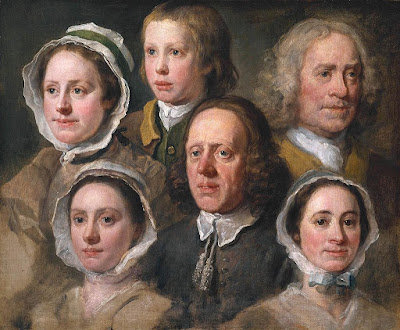The social role of 19thcentury artists was ambiguous, just as it is today.
 |
|
Heads of Six of Hogarth’s Servants, 1750-55, William Hogarth, courtesy of the Tate Gallery
|
William Henry Fox Talbot was an English scientist and inventor. He helped create the modern photo developing process. A classic 19th century polymath, he was also an avid Assyriologist and a Minister of Parliament.
Talbot lived for many years in Edinburgh. His longest stay was in the house where I’m working. He lived here with his wife, two unmarried daughters, a visitor, a butler, a footman, a lady’s maid, a cook, a kitchen maid, two upper housemaids and a lower housemaid. That’s eight servants to wait on five people.
A good part of my day yesterday was spent resolving a drawing problem with the floor-to-ceiling shutters. Those in the drawing room are not the same as those in the music room. It’s possible that I’ve stared at those shutters more intensely than since they were last dusted by a Victorian housemaid.
 |
|
George Clive and his Family with an Indian Maid, 1765, Joshua Reynolds, courtesy Gemäldegalerie, Berlin
|
“A visitor” may have been a euphemism for a professional assistant, a worker who would have been neither upstairs nor downstairs but occupying the netherworld between classes. An artist employed to paint a portrait of the mistress of the house was of uncertain status. Had I the reputation of Sir Edwin Landseer, I might have been in a guest room on the fourth floor. More humble artists would have been squashed in with the senior servants on a lower floor.
Only a handful of households were able to employ the vast array of servants we’ve seen on television. ‘Upper’ servants were the butler, footmen, cook, housekeeper, senior maids and governess. ‘Lower’ servants were the kitchen and scullery maids, laundresses, nursemaids, housemaids, and outdoor help.
To afford a maid-of-all-work, a household needed an income of around £150 per annum, or the very bottom of the professional classes (£18,000 in modern money). This poor skivvy worked terrible hours doing dirty work—cleaning and restocking the heating grates, emptying chamberpots, scrubbing, washing dishes, doing the laundry, and even cooking.
 |
| I needed a t-square to draw those shutters properly. |
Male domestics were taxed, so they were a sign of a wealthier household. Talbot did not employ a housekeeper, so managing the household would have fallen within the butler’s remit. By the time a man could afford a butler, he had an income of more than £1000 per year (£120,000 in modern money).
The garden floor retains its original layout under its slick new surfaces. There’s a large kitchen with scullery and pantry behind. There would have been a ‘coal hole’ somewhere along an outside wall. The next floor up would have been the domain of senior servants. It might have included a box room where the master could conduct his experiments in photography.
 |
| Walking young Poppy in Moray Gardens. |
I’m upstairs, working in the drawing room. These are long days behind the easel, if I’m to finish this portrait in a week. At noon I walked down to Princes Street to find a t-square. Then I worked until the natural light had turned sour. My subject was at the symphony, so I snagged her dog and walked through gardens and along the Water of Leith as twilight rose.
Now I must catch her for a few moments before she’s off to St. Andrews and golf. But first, she made me porridge and left it in the Aga, because I’m actually an honored guest. Our 21st century social roles would have seemed inscrutable to Henry Fox Talbot.




